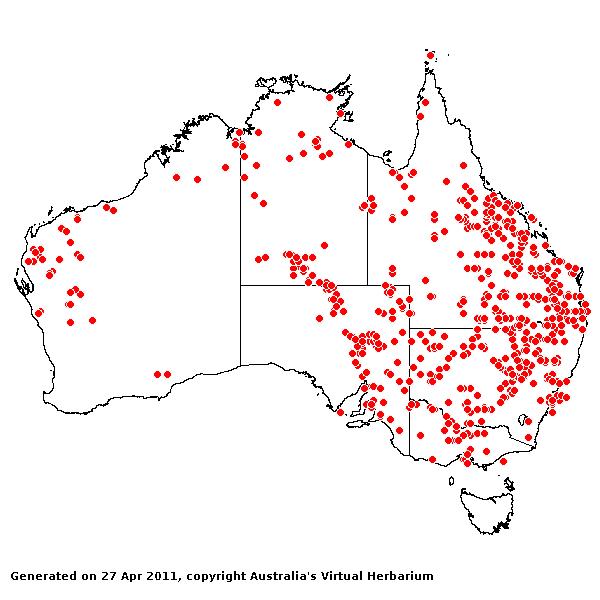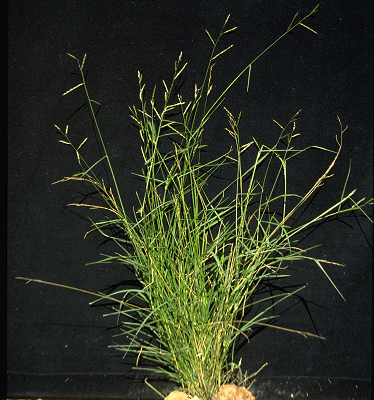Eriochloa pseudoacrotricha (Stapf ex
Thell.) J. M.Black. Trans. & Proc. Roy. Soc. South Australia 67: 43
(1943).
Classification. (GPWG 2001) : Subfamily
Panicoideae. Paniceae.
Basionym and/or
Replacement Name: Eriochloa
ramosa var. pseudoacrotricha Stapf ex Thell., Viert. Nat. Ges.
Zurich 64:697 (1919).
Type of Basionym or
Protologue Information: Australia: Coll? (K holo).
Key references
(books and floras): [1810]. R.Brown, Prodromus (188 as Milium
punctatum), [1952] C.A.Gardner, Flora of Western Australia 1 Gramineae
(232), [1981] M.Lazarides in J.Jessop (ed)., Flora of Central Australia
(478), [2002] D.Sharp & B.K.Simon, AusGrass, Grasses of Australia,
[2006] J.Jessop, G.R.M.Dashorst, F.M.James, Grasses of South Australia
(454), [2008] S.W.L.Jacobs, R.D.B.Walley & D.J.B.Wheeler, Grasses of New
South Wales (264).
Illustrations:
[1952] C.A.Gardner, Flora of Western Australia 1 Gramineae (233,
Pl. 69), [1984] N.T.Burbidge. rev. S.W.L.Jacobs, Australian Grasses (139), [2006] J.Jessop, G.R.M.Dashorst,
F.M.James, Grasses of South Australia (454, fig. 386), [2008] S.W.L.Jacobs,
R.D.B.Whalley & D.J.B.Wheeler, Grasses of New South Wales, 4th edn
(264).
Habit.
Perennial. Culms erect, 20–100 cm tall, 1–2.5 mm diam., 2–5 -noded. Mid-culm
nodes pubescent. Lateral branches sparsely branched. Leaf-sheaths glabrous on
surface. Ligule a fringe of hairs, 0.6–1 mm long. Leaf-blades involute, 7–30 cm
long, 1.5–7 mm wide. Leaf-blade surface scabrous, glabrous or indumented.
Inflorescence.
Inflorescence compound, a panicle of racemes. Racemes 2–10, appressed, 2–10 cm
long. Central inflorescence axis 5–18 cm long.
Spikelets.
Spikelets pedicelled. Fertile spikelets 2-flowered, the lower floret barren
(rarely male), the upper fertile, comprising 1 basal sterile florets,
comprising 1 fertile floret(s), without rachilla extension, lanceolate,
dorsally compressed, 3.6–6 mm long.
Glumes. Glumes
thinner than fertile lemma. Upper glume lanceolate or ovate, 3.7–5.2 mm long,
membranous, without keels, 5 -nerved. Upper glume surface indumented. Upper
glume apex muticous or mucronate or awned. Florets. Basal sterile
florets 1, barren, without significant palea. Lemma of lower sterile floret 90
% of length of spikelet, 5 -nerved.
Fertile lemma 2.3–2.7
mm long, without keel, 5 -nerved. Lemma apex mucronate. Anthers 3.
Continental
Distribution: Australasia and South America.
Australian Distribution:
Western Australia, Northern Territory, South Australia, Queensland, New South
Wales, Victoria.
Western Australia:
Gardner, Hall, Dampier. Fortescue, Ashburton, Carnarvon, Austin. Northern
Territory: Darwin & Gulf, Central Australia North, Central Australia
South. South Australia: Lake Eyre, Gairdner-Torrens Basin, Flinders
Ranges, Eastern, Yorke Peninsula, Southern Lofty. Queensland: Burke,
Burnett, Cook, Darling Downs, Gregory North, Leichhardt, Maranoa, Mitchell,
Moreton, North Kennedy, Port Curtis, South Kennedy, Warrego, Wide Bay, Gregory
South. New South Wales: North Coast, Central Coast, Northern Tablelands,
North-Western Slopes, Central-Western Slopes, South-Western Slopes,
North-Western Plains, South-Western Plains, North Far Western Plains, South Far
Western Plains. Victoria: Murray Mallee, Riverina, Wimmera.
Notes. In
tropical and subtropical rain forests, temperate wet sclerophyll forests, dry
sclerophyll forests, Brigalow forests, tropical and subtropical sub-humid
woodlands, semi-arid shrub woodlands, shrub steppe shrublands, acacia
shrublands, arid tussock grasslands, and arid hummock grasslands. A widespread
native species which tends to intergrade with E. crebra and E.
australiensis.







